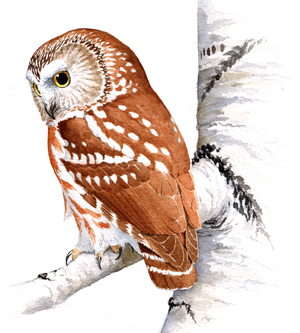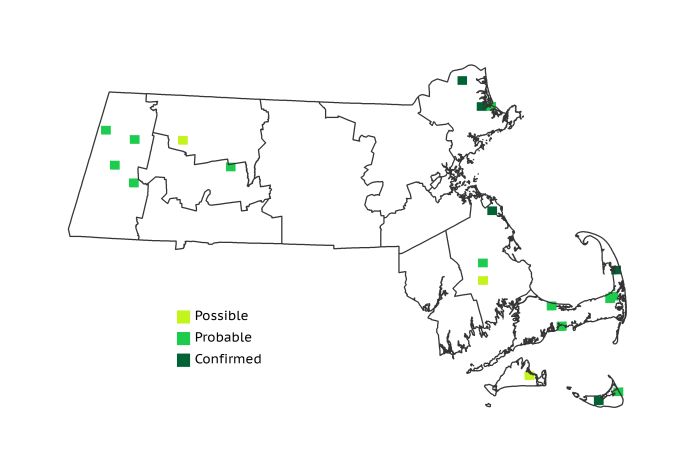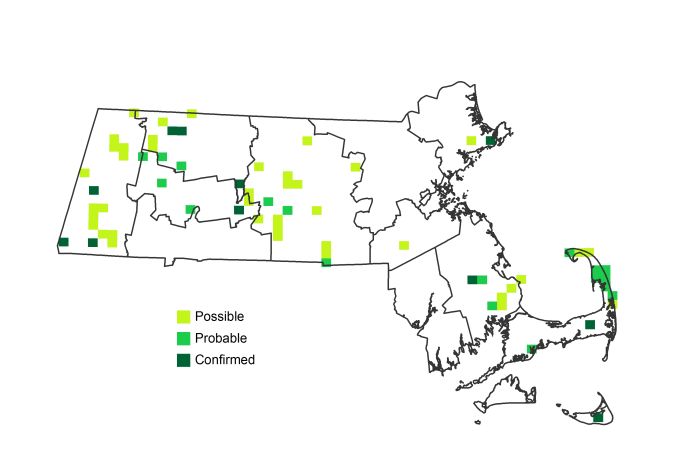Find a Bird
Northern Saw-whet Owl
Aegolius acadicus

Local and strongly increasing
“The Little Owl is known in Massachusetts by the name of the "Saw-whet," the sound of its love-notes bearing a great resemblance to the noise produced by filing the teeth of a large saw.” – John James Audubon, Birds of America
The particular call referenced by the bird’s name is not given very frequently, but then, Northern Saw-whets are among the least vocal of our owl species. Beginning in late winter they can sometimes be heard giving a steady series of hollow toots or whistles, sometime for minutes at a time. Even when these owls make their presence known, the combination of their small size and reluctance to move during daylight make them very difficult to track down. Nevertheless, the Atlas data suggest that these reclusive denizens of mixed second-growth woods are becoming more widespread.
Historic Status
Historical accounts of Northern Saw-whet Owls (or Acadian Owls, as they were long ago known) are laced with words like “probably” and “apparently.” In the age before tape recordings and flashlights the species’ strictly nocturnal activities made them hard to see, and their saw-whetting call – their repetitive two-syllable “saw filing” – was only discovered as being connected to the bird when John James Audubon opened the door to his mill to see who was working on the equipment (Audubon 1840). Most historic encounters with Northern Saw-whet Owls came in connection with nonliving specimens and rarely with living birds in the field. Their historic nesting trends in Massachusetts are therefore difficult to discern.
Atlas 1 Distribution
The Northern Saw-whet Owl may be one of the most frequently overlooked birds in the Commonwealth. The apparent paucity of breeding records in Atlas 1 suggests that the species was either quite rare during that period or else was missed by observers. Likely both factors contributed to some degree; the birds were found in only half a dozen blocks from the Worcester Plateau west despite plenty of apparently suitable habitat. The Coastal Plains had only 4 blocks with evidence of breeding Northern Saw-whet Owls, 3 of which were in Essex County. The mixed pine-oak woods of the Bristol/Narragansett Lowlands and the Cape and Islands were clearly more attractive to saw-whets since these two regions combined accounted for nearly half of the individuals encountered during Atlas 1.
Atlas 2 Distribution and Change
Albeit small in numbers, saw-whets almost quadrupled their distribution in Massachusetts between the Atlases. Three areas – the far west, the Lower Worcester Plateau, and Cape Cod – showed distribution surges, while the rest of the ecoregions that hosted the species in Atlas 1 saw only small fluctuations. As birds that love their forest edges, the return of forest habitat to Massachusetts can only be a boon for this species.
Atlas 1 Map

Atlas 2 Map

Atlas Change Map

Ecoregion Data
Atlas 1 | Atlas 2 | Change | ||||||
Ecoregion | # Blocks | % Blocks | % of Range | # Blocks | % Blocks | % of Range | Change in # Blocks | Change in % Blocks |
Taconic Mountains | 1 | 6.3 | 5.3 | 3 | 12.0 | 4.3 | 2 | 13.3 |
Marble Valleys/Housatonic Valley | 0 | 0.0 | 0.0 | 5 | 12.8 | 7.1 | 5 | 12.8 |
Berkshire Highlands | 3 | 5.5 | 15.8 | 9 | 16.4 | 12.9 | 4 | 7.5 |
Lower Berkshire Hills | 0 | 0.0 | 0.0 | 5 | 16.1 | 7.1 | 5 | 18.5 |
Vermont Piedmont | 1 | 5.9 | 5.3 | 2 | 11.8 | 2.9 | 0 | 0.0 |
Berkshire Transition | 0 | 0.0 | 0.0 | 2 | 5.0 | 2.9 | 1 | 3.2 |
Connecticut River Valley | 0 | 0.0 | 0.0 | 1 | 1.5 | 1.4 | 1 | 2.1 |
Worcester Plateau | 1 | 1.3 | 5.3 | 3 | 3.4 | 4.3 | 0 | 0.0 |
Lower Worcester Plateau | 0 | 0.0 | 0.0 | 12 | 15.0 | 17.1 | 7 | 13.0 |
S. New England Coastal Plains and Hills | 4 | 1.5 | 21.1 | 8 | 2.8 | 11.4 | 0 | 0.0 |
Boston Basin | 0 | 0.0 | 0.0 | 0 | 0.0 | 0.0 | 0 | 0.0 |
Bristol and Narragansett Lowlands | 2 | 1.9 | 10.5 | 1 | 0.9 | 1.4 | -1 | -1.0 |
Cape Cod and Islands | 7 | 5.1 | 36.8 | 19 | 13.2 | 27.1 | 11 | 9.2 |
Statewide Total | 19 | 2.0 | 100.0 | 70 | 6.8 | 100.0 | 35 | 4.2 |
Notes
Since it is likely that all owl species, and this one in particular, are underestimated by Atlas methods, a statewide effort dedicated to making nighttime surveys might reveal that the Northern Saw-whet Owl is more widespread and numerous than currently supposed.



